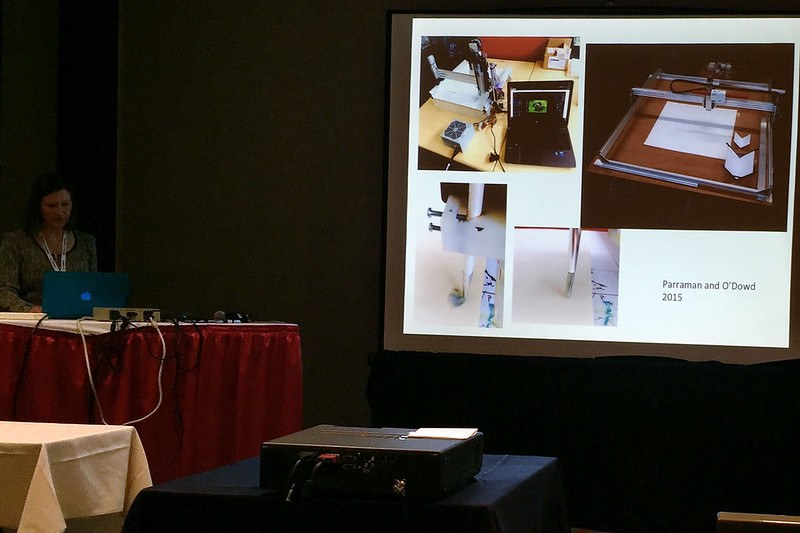
Oil painting robot.
[ <<previous | index | next >> ]
23:44
It's been a long day, but fun. This morning we allowed ourselves a sleep in until 08:00, since the first conference talks I wanted to attend didn't start until 09:10. We did the breakfast routine with Grape Nuts and milk and yoghurt from the hotel cafeteria. Then I went to my talks while M. hung around in the room a bit before leaving to drop off a bag of laundry at Pete's Cleaners, a place near the Stockton Tunnel which we'd used last time we were here. They charged $15 for a bag wash of everything we've worn so far this week. Then she walked down Market Street west towards Hayes Street to explore some of the shops along that street.
The morning sessions of the conference began with talks on 3D scanning. One was about fixing intermediate depth assignments for pixels on the edges of foreground objects in front of a more distant background. One was generating a deformable 3D model template from video of moving non-rigid objects, such as people or animals. And one was about integrating scans from multiple Microsoft Kinect 3D sensors into a single 3D colour model.
After the coffee break I attended another session of the Colour conference, this one about printing. There was a talk about choosing optimal compression algorithms for printing, followed by one about predicting how much toner a page would take to print (apparently not a straightforward problem). Then there was one about dithering of colours in 3D printing, which is much more complicated than in 2D printing, because surfaces can appear at any angle in three dimensions, and the dithering patterns can produce visible moiré effects if they're not optimised properly for all viewing angles. The last two talks were essentially two parts of one long talk about a project to construct and program a robot to take a given image, then convert the image to a set of brush strokes, then paint it using an actual paintbrush and paints. This was by the same woman who had talked about cadmium red yesterday. The system worked with oil paints and took account of the layering and the textures created by applying paint thickly. It was quite interesting, but I think it has a lot of unfulfilled potential yet, like mixing paint colours on the canvas.
 Oil painting robot. |
I returned to the hotel room to charge my laptop over lunch, and M. had just arrived back from her walk to Hayes Street. So we went out to get bagels for lunch, at Noah's Bagels on Bush Street, down near Market Street, which is a good walk to do during the lunch break. We both got pumpernickel bagels, M. with peanut butter, and me with cream cheese and smoked salmon. On the way back we stopped in at Crocker Galleria, where there was a small food market set up with stalls on the lower floor. There were baked goods, dried fruit, nuts, honey, cheese, flowers, and fresh fruit and vegetables. We bought three pink lady apples, one for me for an afternoon snack and two for us tomorrow. Then I left M. to browse the shops of the Galleria while I went bCk to the conference.
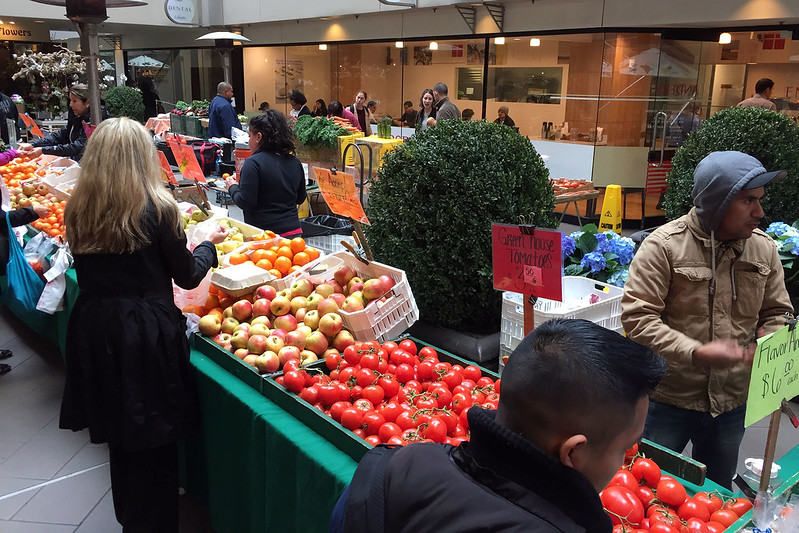 Farmer's market in Crocker Galleria. |
The final afternoon I like to attend the Human Vision conference, because they have sessions on Art, Aesthetics, and Perception, about the crossover between art and the neuroscience of human vision, which is absolutely fascinating stuff. The first talk was a keynote by Barry Sandrew, who told us that he was the inventor of the process for digitally colourising black and white films (he is the founder of Legend Films and Legend3D). Before him, it had only ever been done in a painstaking analogue process using film masks. He was the first to do it on a computer, but the process was originally still very tedious, only becoming easier over time. He has also done a lot of 3D conversions of movies shot in 2D. His talk was on lessons learnt from these processes and how they could be applied to the emerging media of augmented reality and virtual reality as forms of entertainment.
He first pointed out that when colourising first took off, quite a few people didn't like it, saying that it ruined the original black and white aesthetic, or that it made the movies "too realistic". Since then, similar comments have been made about 3D films, both ones shot in 3D and ones converted from 2D originals - that it changes something about the film, and for the worse. He then cited the more recent example of high frame rate used by Peter Jackson in The Hobbit trilogy, and how many people didn't like that, because it made the film look "too realistic". The common thread here is that there is a significant population of people who feel more comfortable when movies look "like movies", that is, obviously fake, just an image on a screen, rather than more like reality. This extends to 3D in the fact that many 3D movies deliberately impinge on the viewers' personal space, to get that flinch reaction when something pops out of the screen. He said many people simply don't like this, for psychological reasons. He said the best 3D movies don't do this, they are restrained enough that you can basically forget it's 3D and just enjoy it as a passive entertainment. The extension of this is that the new technologies of augmented and virtual reality, while being adopted eagerly by gamers for things like first person shooter games, and almost certainly not going to be media used effectively by passive narrative entertainment like movies. When people want to watch a movie, they actually don't want to be surrounded by the action or feel the visceral feeling of "being there" - they want the story to unfold in that detached manner you get when observing something from a distance.
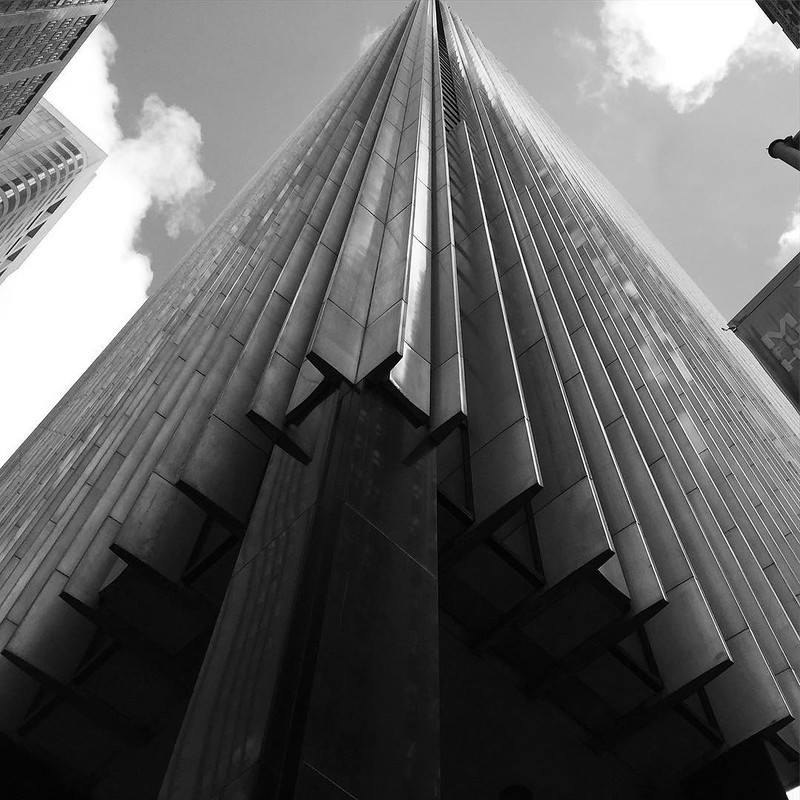 50 California Street, San Francisco. |
It was an interesting talk and made a lot of thought provoking points. It got even more interesting when during question time a man stood up and said that colourisation and 3D conversion were bad, because they messed with the original interpretation of a movie, that it changed the director's vision, that the director filmed it that way because they had control of the creative process. The speaker actually got angry, saying, "That's bullshit! Maybe if you're Spielberg or Scorsese you might have creative control, maybe. But anyone else, the studio says, 'You're filming this in 2D, or goodbye! We'll get someone else.' Directors don't have creative control over things like that!" It's always fun when there's a heated exchange between a speaker and questioner at a scientific conference.
After this talk was one about human visual motion processing, which included some demonstrations using faint patterns on the slide projector screen with the room lights turned off. The speaker demonstrated that we could sense motion in the peripheral vision region even when there is no luminance contrast, when there is only faint chrominance contrast. With a show of hands, he showed that most of the audience could see the effect, which he said proved that peripheral motion processing in the visual system relies on information from colour sensitive cone cells, rather than just the brightness-sensitive rod cells as has previously been widely believed.
The last talk of the session was about trying to quantify and measure the concept of "interestingness" in images. They did a large user study where they had observers rate and rank photos for how interesting they were, as well as what features of the images they found more or less interesting. The conclusions were that there does seem to be some level of universality to the concept of interestingness - i.e. there are photos which many people over a large sample rate as consistently more interesting than other photos, though with some individual variance. Interestingly (pun intended), there was a high correlation of interestingness with images that the observers also labelled as "unusual". So the conclusion was that unusualness is a major factor in what makes a photo interesting, and because what is unusual can vary a lot between cultures, that what photos people find interesting may also be highly culture dependent. This would be tested with future study.
The last session of the conference was more art stuff. There was a paper by one Jack Ox (who was a woman) that sounded interesting from the title: "Colour systems are categories that carry meaning in visualisations: a conceptual metaphor theory approach". But once she started talking, it was just a blur of dense psychology buzzwords that honestly sounded like pop psychology put into a blender rather than any sort of hard science. It was rather disappointing. And she was reading from her laptop in a monotone the whole time, without looking at the audience, and went severely over time. The chairperson stood up and tried to signal to her to wind it up, but went completely unnoticed.
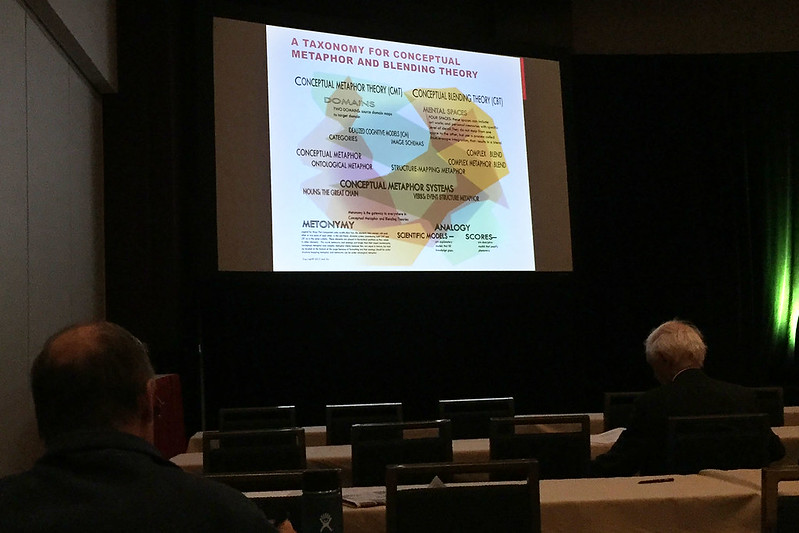 A slide from "Colour systems are categories that carry meaning in visualisations: a conceptual metaphor theory approach". |
The next talk was better, about using Bayesian inference as a prediction model across various art forms. The speaker began with music, which is sequential by its very nature, and so allows the listener to hear a progression of notes or chords over time, and form a mental prediction of the next note to come. When the prediction is fulfilled, the listener gets a sense of satisfaction and resolution, while if the prediction is defied it gives the music tension. Composers have known this for ages, of course, and use it all the time. The speaker wanted to extend the idea to visual art, using experiments in gaze tracking to give a temporal sequence to how people look at the various features of images and artworks, as well as extending the idea to concepts. For example, if an image contains a sad face, your brain might (subconsciously) predict the colour blue, since that has an association with sadness in our culture, then your visual system will seek out blue tones in the image, to see if they are present, thus reinforcing the theme, or absent, thus subverting it in a surprising way. He's only taken a few early steps towards researching this so far, so didn't have full results to present, but said his early work was promising.
By the time this talk was over, the session was running so far behind that I had to skip the next talk completely, which I'd wanted to attend before leaving to get ready and travel to our dinner appointment with our friends Lisa, Rick, Mary, Casey, and Andy. They had booked a table at Salang Pass Restaurant in Fremont, an Afghani place which sounded delicious to us. We had to take BART from Powell St to Fremont, and then walk about half an hour to get there. So we wanted to catch the 17:25 train to give ourselves plenty of time.
It was fortunate we allowed time, since there was a confusing sign and announcement for a train leaving around the right time, and we discovered when we reached Oakland that we were on the wrong train! We had to get off and walk downstairs to another platform and then catch a Richmond-Fremont train. But this manoeuvre only cost us a few minutes and we reached Fremont with plenty of time to walk. The sun had gone down however, and weren't sure exactly where the restaurant was as I left the free conference WiFi before checking on Google Maps, and the street number wasn't on my offline map. But we had a rough ides what block it was on, so walked down to Fremont Boulevard and then along it to the west until we started approaching nearby street numbers. I had the restaurant number memorised as 37642, and we were walking in the direction of decreasing numbers on the odd side of the street, so when we got close we crossed to the even side, and the first thing we saw was a church with number 37558. We concluded we'd walked a bit too far and backtracked, but passed 37642 with no sign of the restaurant. We had no way to double check the location without net access, but I looked at my notes and found the number was actually 37462, so it was back past the church. By this time we'd been walking in the cold darkness for quite a while, so we were happy to find the restaurant right where it should have been just a few doors past the church again.
We were the first to arrive and the restaurant staff set up a table of 12 for us, which seemed a bit high for the numbers I was expecting, even more-so with Shaenon and her husband not attending. Soon Lisa and Rick arrived, followed by Mary, then Casey and Audrey and young Owen. We chatted and ordered some appetisers to share: bread with hummus, yoghurt, yoghurt with cucumber and spices, vine leaves, fried potatoes, and some pumpkin cooked very soft with honey or something like that. We were wondering where Andy was, when Casey got a text message from him, saying that he'd forgotten about the dinner and was it too late to come?! Casey said he messaged back: "Get your ass to Mars".
Andy eventually showed up, as our main meal selection arrived. Rick and some of the others had just chosen a few dishes for everyone to share, including a lamb dish, a chicken one, a bigger serve of the pumpkin, a spinach dish, and M. had asked for one of the vegetarian platter dishes, which consisted of spinach, eggplant, and a side bowl of lentil soup. It was good to finally meet Andy after all these years - we've known each other for well over twenty years now. Of course we swapped a lot of stories about the success of his book, The Martian, and then I asked him if he'd write a foreword for my Irregular Webcomic book which I'll be Kickstarting soon. He said he'd love to.
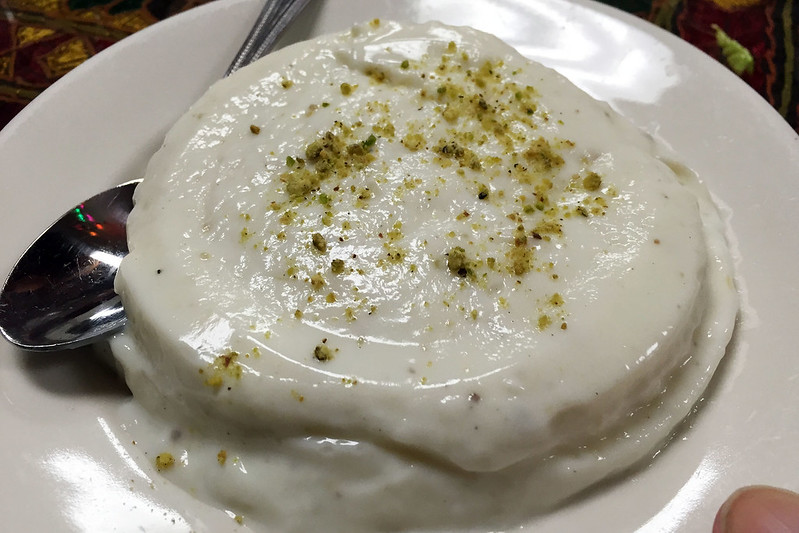 Firni at Salang Pass Restaurant. |
After the main course was done, we continued chatting for some time, then ordered some dessert. Most people had mango ice cream, but Mary recommended the firni, which was a milk pudding flavoured with rosewater and pistachio, so I had one of those for something different. It was creamy and delicious, like a soft pannacotta. We also shared around the packet of Fantales we'd brought from home, and everyone liked them.
When it was time to go, they juggled cars around until Audrey ended up giving us a lift to the Fremont BART station. From there we got a train back, having to change at Bayfair because of the restricted night schedule. We got back to the hotel a bit after 23:00. I had a shower while M. finished reading her novel, which she didn't want to have to take back on the plane. We finally went to sleep after midnight.
[ <<previous | index | next >> ]